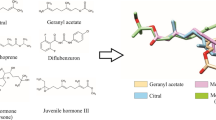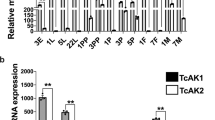Abstract
THE juvenile hormone of insects promotes larval development but prevents metamorphosis. Its presence in an immature insect ensures that when the larva molts it will retain its larval characters and not differentiate into an adult1. Extracts with juvenile hormone activity were first prepared from the abdomens of male Cecropia moths by Williams2. Afterwards active extracts were prepared from adult males and females of 6 families of Lepidoptera as well as from eggs, larvæ and newly moulted pupæ3,4, from representatives of 6 other orders of insects including Dictyoptera, Orthoptera, Hemiptera, Coleoptera, Diptera and Hymenoptera4–7 and from various insect products, for example, royal jelly7, insect fæces8. Investigation of other groups uncovered substances with juvenile hormone activity in extracts of the adrenals of cattle9 and in many tissues of numerous invertebrates in 13 classes, including Hydrozoa, Anthozoa, Anopla (Nemertinea), Cheilostomata and Ctenostomata (Ectoprocta), Pelycepoda, Gastropoda, Polychaeta, Oligochaeta, Malacostraca, Arachnida, Holothuroidea and Balanoglossida6,7. The most active invertebrate sources were the eye-stalks of crustaceans (Homarus and Carcinides)6,7, and the heads of polychaetes (Nereis)7. Juvenile hormone activity was later demonstrated in many vertebrate tissues besides the adrenals including pituitary, kidney and thymus10 and lymphatic, parathyroid, thyroid, mammary and gastric mucin (Schneiderman, H. A., and Gilbert, L. I., unpublished observations).
This is a preview of subscription content, access via your institution
Access options
Subscribe to this journal
Receive 51 print issues and online access
$199.00 per year
only $3.90 per issue
Buy this article
- Purchase on SpringerLink
- Instant access to full article PDF
Prices may be subject to local taxes which are calculated during checkout
Similar content being viewed by others
References
Wigglesworth, V. B., Symp. Soc. Exp. Biol., 2, 204 (1957).
Williams, C. M., Nature, 178, 212 (1956).
Schneiderman, H. A., and Gilbert, L. I., Anat. Rec., 128, 618 (1957).
Gilbert, L. I., and Schneiderman, H. A., Anat. Rec., 131, 557 (1957).
Wigglesworth, V. B., J. Inst. Physiol., 2, 73 (1958).
Schneiderman, H. A., and Gilbert, L. I., Biol. Bull., 115, 530 (1958).
Schneiderman, H. A., Goldberg, M. J., and White, J. F. (unpublished observations).
Karlson, P., and Schmialek, P., Z. Naturforsch., 14, b 821 (1959).
Gilbert, L. I., and Schneiderman, H. A., Science, 128, 844 (1958).
Williams, C. M., Moorhead, L. V., and Pulis, J. F., Nature, 183, 405 (1959).
Gilbert, L. I., and Schneiderman, H. A., Trans. Amer. Micro. Soc. (in the press).
Schneiderman, H. A., and Gilbert, L. I., “Cell, Organism and Milieu”, edit. by Rudnick, D., 157 (Ronald Press, New York, 1959).
Hisaw, F. L., “Comparative Endocrinology”, edit. by Gorbman, A., 533 (Wiley, New York, 1959).
Author information
Authors and Affiliations
Rights and permissions
About this article
Cite this article
SCHNEIDERMAN, H., GILBERT, L. & WEINSTEIN, M. Juvenile Hormone Activity in Micro-organisms and Plants. Nature 188, 1041–1042 (1960). https://doi.org/10.1038/1881041a0
Issue date:
DOI: https://doi.org/10.1038/1881041a0
This article is cited by
-
10.1007/BF00335614
CrossRef Listing of Deleted DOIs (2011)
-
10.1007/BF00297098
CrossRef Listing of Deleted DOIs (2011)
-
Insect juvenile hormones and pheromones of isopentenoid biogenesis
Lipids (1978)
-
Juvenile Hormone Activity of Isomers of Farnesol
Nature (1962)
-
The antimicrobial activity of some insect extracts possessing juvenile hormone activity
Experientia (1962)



